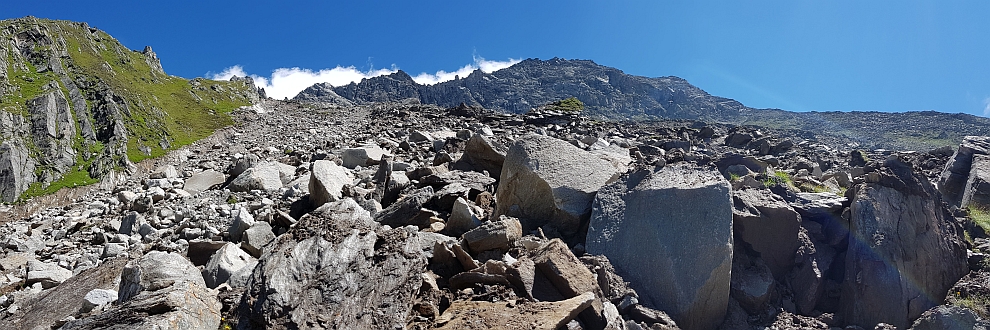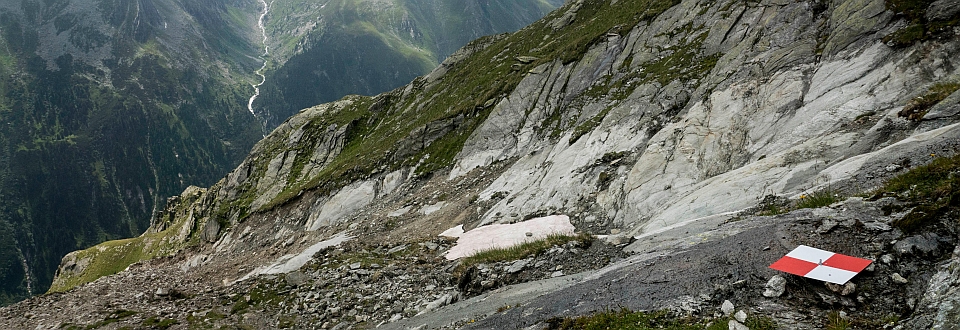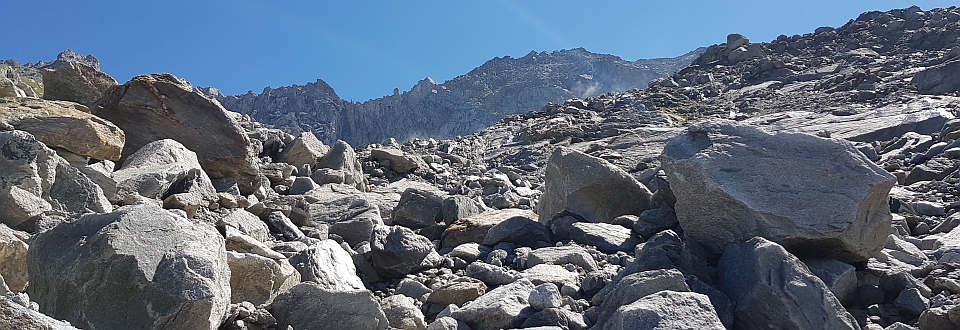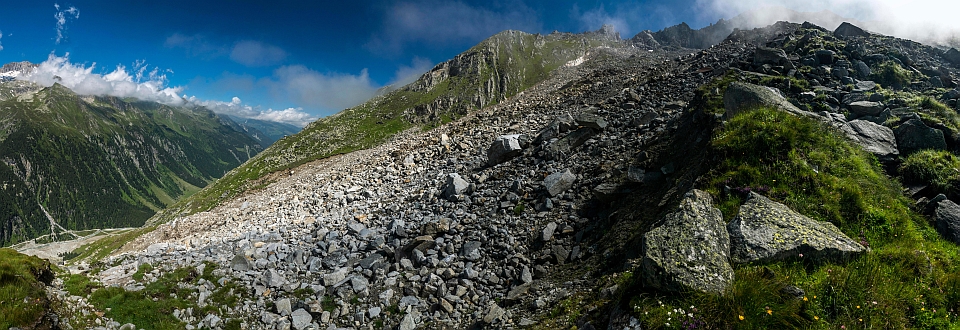Project Climatic Sensitivity of high-alpine Cirques
Long-term Monitoring
Glacial cirques, located immediately below the highest peaks and headwalls, represent the uppermost location for substantial sediment storage in high-alpine environments. Pronounced recent climatic warming causes considerable, potentially dramatic, changes in these areas. Rising air temperatures and increased liquid precipitation induce substantial, and possibly rapid, subsurface warming. For frozen debris deposits, this can result in significant permafrost degradation, leading to the reduction of cohesion and stability, and ultimately to the provision of sediment to potentially hazardous mass wasting processes such as landslides and debris flows. Due to intense recent and past (peri-)glacial erosion and their concave, deposition-friendly morphometry, cirques frequently possess considerable debris volumes. Changes in the sediment mobilisation regime are therefore especially impactful in these environments.
Reference site Sattelkar: The remote Sattelkar cirque and its neighbouring cirques are located in the Obersulzbachtal, Hohe Tauern Range, in an elevation range between approximately 2.100-2.800 m above sea level (asl). Strong surface displacements have been observed in the Sattelkar since 2005. The initial displacements triggered massive degradation of the vegetation cover and the exposure and enhanced mobilisation of the debris cover. Terrain analysis revealed that a deep-seated, retrogressive movement in the debris cover of the cirque had been initiated. Heavy precipitation is assumed to cause spreading and sliding of the glacial and periglacial debris cover on the underlying, smooth bedrock cirque floor. Detailed aerial photo analyses, witness reports and damage documentations demonstrated that local mass movement and debris flow activity has steadily increased over the last decade. During this period, debris flows from the Sattelkar blocked the Obersulzbach river, and, in combination with the general flooding situation in the catchment, caused substantial destruction in the middle and lower reaches of the Obersulzbach river.
Based on a long-term monitoring approach, we systematically and continuously observe the atmospheric, surface and subsurface conditions to quantitatively assess ground thermal conditions and mass wasting activity. Based on these measurements, we hope to improve our understanding how high-alpine cirques react to climate change and which natural hazard potential can be expected in the foreseeable future.
SELECTED REFERENCES
Hartmeyer, I., Keuschnig M., Krautblatter, M.: Permafrost degradation in the Eastern Alps: Insights from three long-term monitoring sites in the Hohe Tauern Range, Salzburg. Austria. Proceedings 14th D-A-CH Permafrost Conference 2024, Oberelsbach, Deutschland (10.-12.01.2024). Seite 8, 2024.
Otto, J-C., Schroeckh T.R., Keuschnig, M.: Assessing rock glacier activity in the Austrian Alps using radar interferometry and image correlation techniques. EGU General Assembly 2024, Vienna, Austria, 14–19 Apr 2024, EGU24-13150, https://doi.org/10.5194/egusphere-egu24-13150, 2024.
Hartmeyer I., Keuschnig M., Krautblatter M., Otto, J-C., Valentin, G.: Permafrost thaw and its effects on the occurrence of natural hazards: three long-term case studies from the Hohe Tauern range. INTERPRAEVENT Proceedings, 2024.
Hochgebirge im Klimawandel, Langzeitmonitoring im Nationalpark Hohe Tauern. Ö1 Dimensionen, 27.09.2022
9 x Österreich. Erkundungen in Salzburg. Vom Außergebirg ins Innergebirg. Ö1 Radiokolleg, 22.09.2022
Klimawandel führt in den Alpen zu mehr Muren und Steinschlägen. Der Standard, Forschung Spezial, 17.08.2022.
Klimawandel im Hochgebirge: „Müssen uns auf große Schäden einstellen". Tiroler Tageszeitung, 21.07.2022.
Forschen an der Existenzgrenze: Wo der Klimawandel in den Alpen sichtbar ist. Salzburger Nachrichten, 21.07.2022
Hermle, D., Gaeta, M., Krautblatter, M., Mazzanti, P., and Keuschnig, M.: Performance Testing of Optical Flow Time Series Analyses Based on a Fast, High-Alpine Landslide. Remote Sensing, 14, 455, https://doi.org/10.3390/rs14030455, 2022.
Hermle, D., Keuschnig, M., Hartmeyer, I., Delleske, R., and Krautblatter, M.: Challenging the timely prediction of landside early warning systems with multispectral remote sensing: a novel conceptual approach tested in the Sattelkar, Austria, Nat. Hazards Earth Syst. Sci., 21, 2753–2772, https://doi.org/10.5194/nhess-21-2753-2021, 2021.
Hermle, D., Gaeta, M., Keuschnig, M., Mazzanti, P., and Krautblatter, M.: Multi-temporal analysis of optical remote sensing for time-series displacement of gravitational mass movements, Sattelkar, Obersulzbach Valley, Austria, EGU General Assembly 2021, online, 19–30 Apr 2021, EGU21-8011, https://doi.org/10.5194/egusphere-egu21-8011, 2021.
Keuschnig, M., Hermle, D., and Krautblatter, M.: A conceptual approach on optimising lead time for the forecasting of landslides using remote sensing systems, EGU General Assembly 2020, Online, 4–8 May 2020, EGU2020-17267, https://doi.org/10.5194/egusphere-egu2020-17267, 2020
Hermle, D., Keuschnig, M., and Krautblatter, M.: Potential of multisensor assessment using digital image correlation for landslide detection and monitoring, EGU General Assembly 2020, Online, 4–8 May 2020, EGU2020-16982, https://doi.org/10.5194/egusphere-egu2020-16982, 2020
Massiver Felsrutsch in Hohen Tauern wirft Fragen auf (2020): ORF Salzburg, 25.09.2020 - https://salzburg.orf.at/stories/3068524/
IPA - International Permafrost Association (2018). Reports from the Adhering Bodies of the International Permafrost Association. ISSN 2221-3775.
Otto J-C., Hartmeyer I., Keuschnig M. (2018): Naturgefahren in alpinen Permafrostregionen und Permafrostmonitoring. Geographische Rundschau 11-2018.
Natur schafft Wissen - Nationalpark Hohe Tauern (2018): ORF 3, Land der Berge.
Hartmeyer I., Keuschnig M., Fegerl L., Valentin G., Helfricht K., Otto J-C. (2017): Long-term monitoring of climate-sensitive cirques in the Hohe Tauern range. 6th Symposium for Research in Protected Areas, Salzburg.




